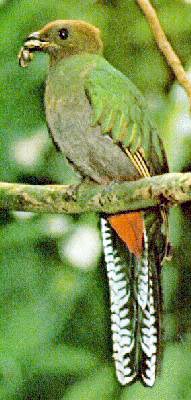
The Quetzal is a bird which can be found in the mountain or "cloud" rain forest of Central America and throughout Amazonia. It is described by Roger Tory Peterson and Edward Chalif in their book, Field Guide to the Birds of Mexico, as "the most spectacular bird in the New World". The bird's body measures about 14 inches in length, about the size of a pigeon. However, it has tail feathers which can extend as long as three feet. Both the male and the female are an iridescent emerald and golden green with tail feathers in iridescent blues and greens with white undertails. The green camouflages them in the rain forest. The male has a head crest and red breast feathers with a white undertail. The females are duller and have fewer red breast feathers and short tail plumes. The Quetzal is truly a splendid bird.
Quetzalcoatl, the Feathered Serpent, was a god of the Toltec-Maya peoples. He is seen wearing the long tail plumes of the male quetzal. The name quetzal is an ancient Mexican term for the tail feather, which means "precious" or "beautiful " The Aztec of Mexico allowed only royalty or the nobility to use the tail plumes of the Resplendent Quetzal. Elaborate headdresses made from the plumes of the male quetzals were worn in Aztec ceremonies. The birds were caught live and their tail feathers were removed. The birds were then released to grow new feathers.
